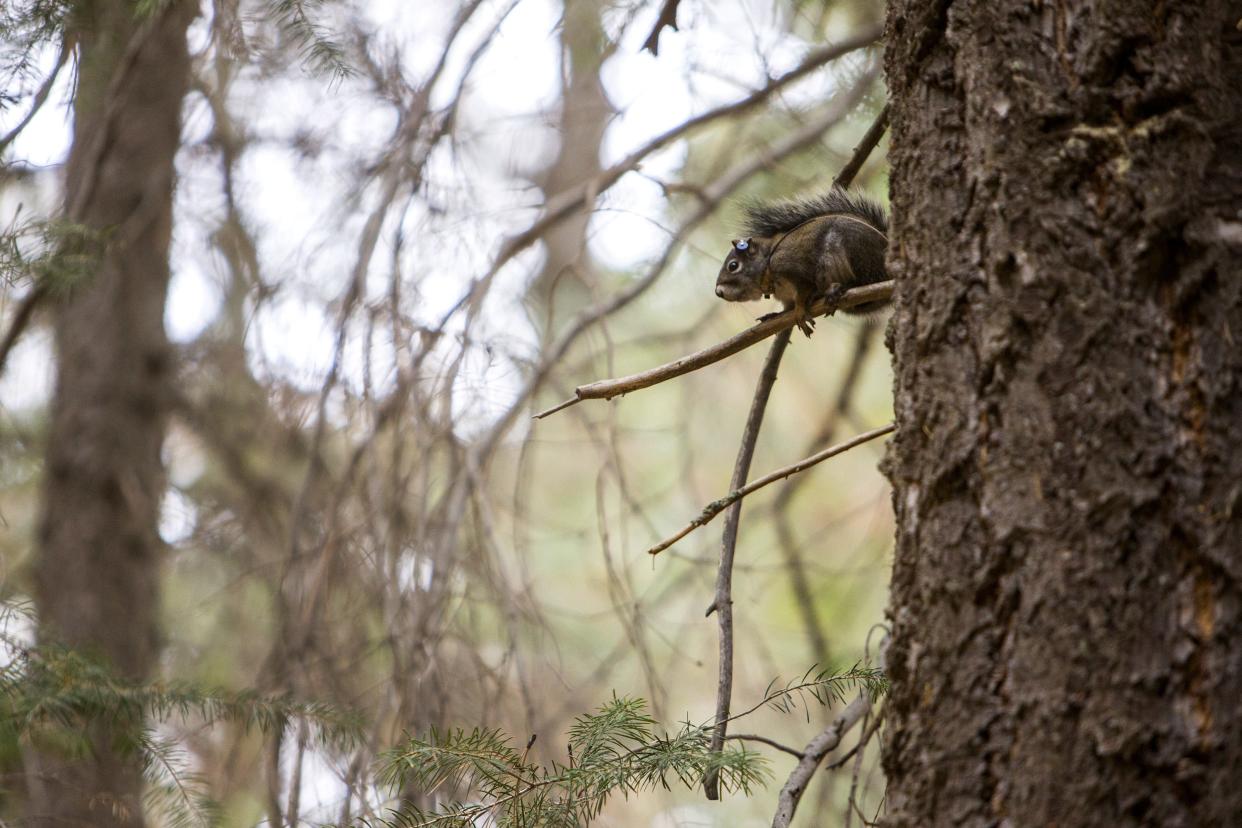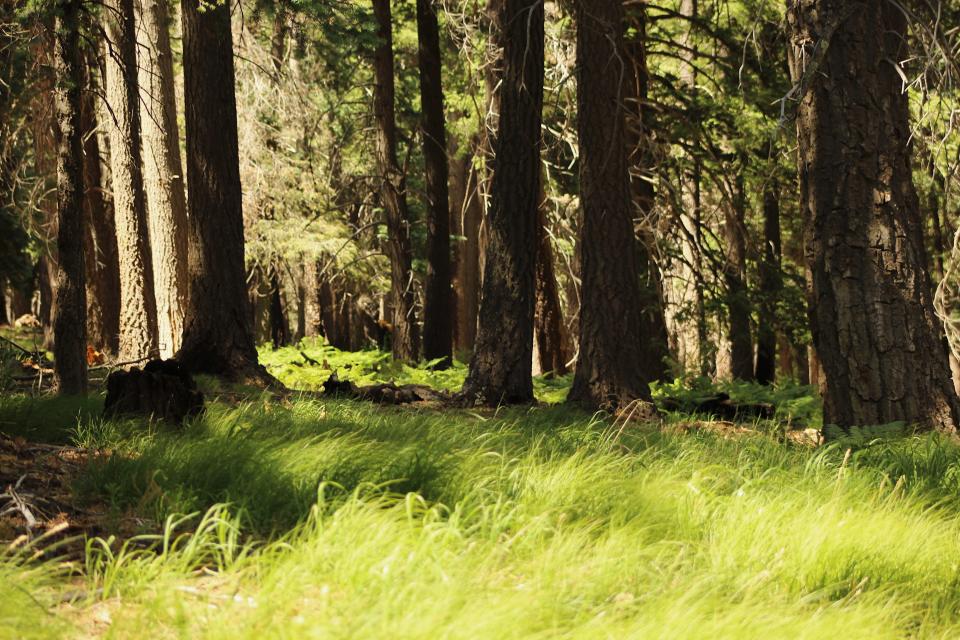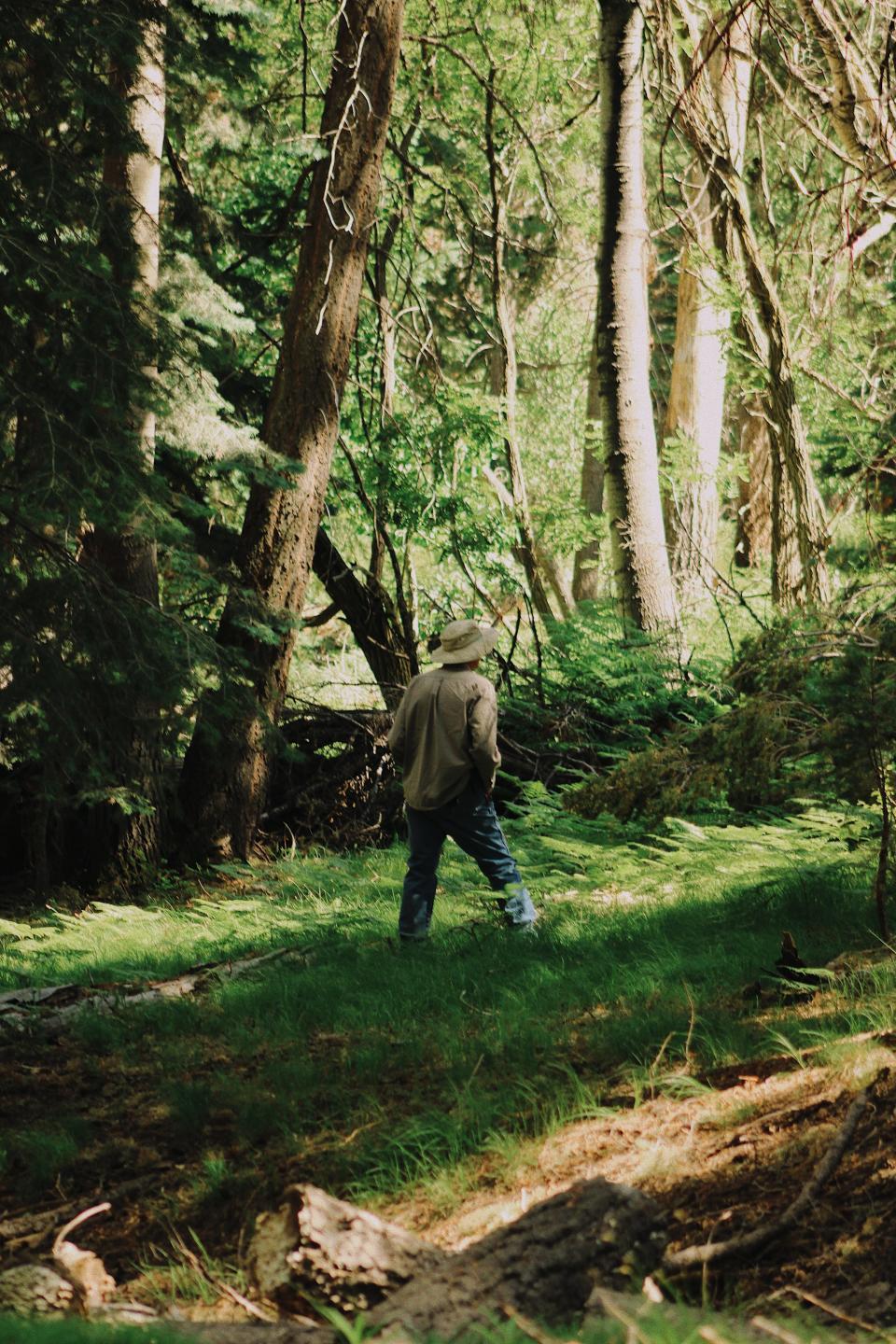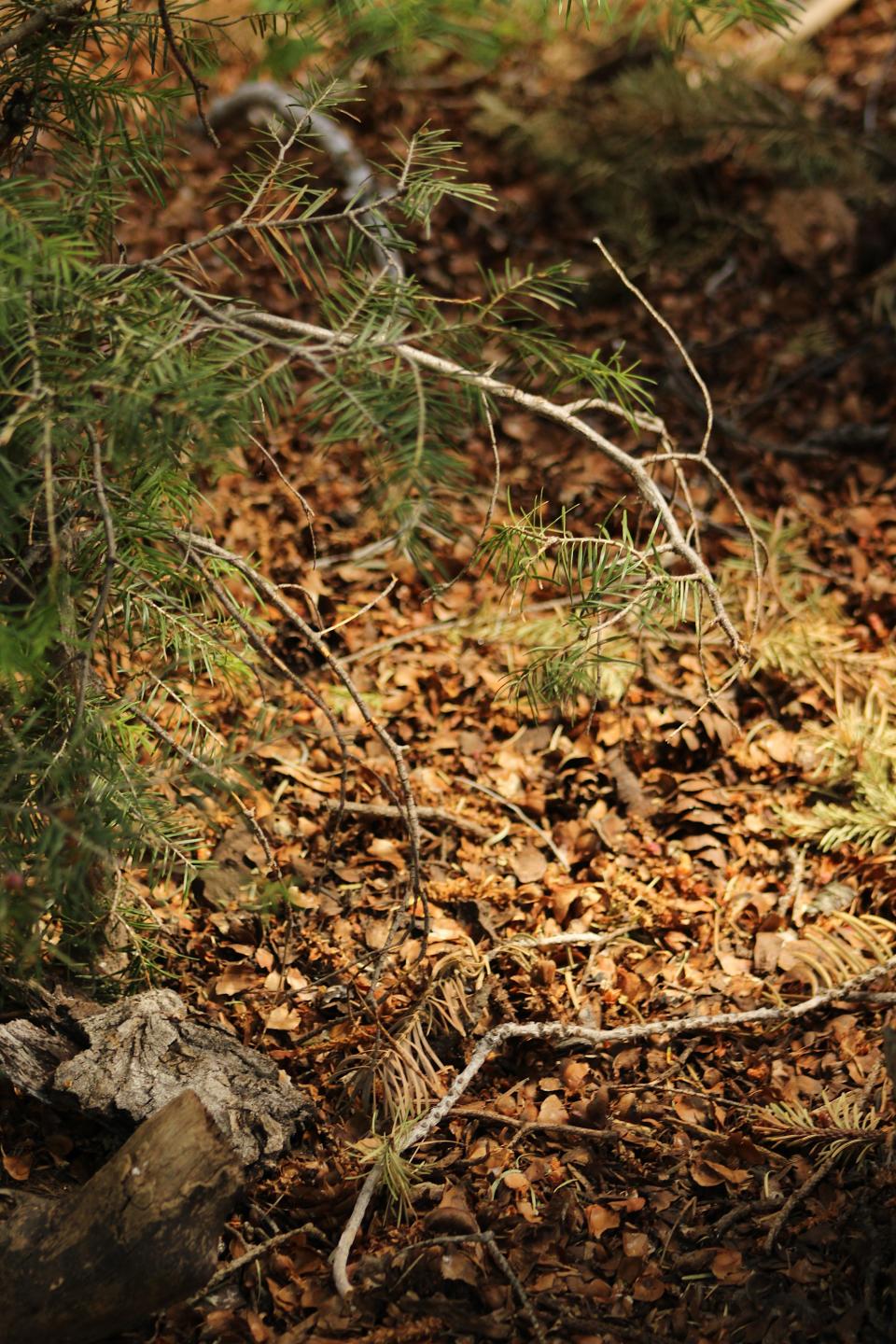How climate change may leave some Sky Island wildlife species in Arizona with no place to go

MOUNT GRAHAM — Up in the spruce-fir forest on the top of Mount Graham, the Center of Biological Diversity's Robin Silver is searching for one of the rarest mammals on Earth.
He uses a tracker in hopes of finding a Mount Graham red squirrel and its midden, the accumulation of cone scales and debris left from feeding. The area he searches is eerily quiet, aside from the buzzing of mosquitos and the snapping of twigs below his boot. He is concerned that after a few hours he has not spotted a single squirrel.
But on the trek back down the mountain, not one, not two, but three Mount Graham red squirrels reveal themselves at separate locales along the roadway. They dart so fast, they could be missed by someone who was not on the lookout. They stop long enough for Silver to identify them by their fluffy tail and red fur along their back, then scramble up the bark of an evergreen and disappear into a habitat as imperiled as they are.
The squirrels' habitat is limited, confined to the highest elevations of Mount Graham by their thermal envelope, or how much cold and warmth they can tolerate for survival. They have evolved on the Madrean Sky Island and are now, in effect, stranded there. The cool and shaded environment provides the perfect habitat for the squirrels, but the loss of canopy from wildfires, exacerbation by warmer and drier conditions, and the increase of development on their range could leave them with no place to go, threatening the remaining 156 squirrels left in the wild.
The species has been in peril for the better part of the last century due to habitat loss, wildfire, disease and climate change. It was listed as endangered in 1987. Cabins encroaching on their habitat have become the squirrel's latest foe, according to the Center for Biological Diversity, which sued the U.S. Fish and Wildlife Service (USFWS) and the U.S. Forest Service (USFS) in the fall of 2022.
“The squirrels are on the brink of extinction,” Silver says. “When the forest they rely on is gone, then they’re gone forever.”
Sky Islands provide a varied but vulnerable habitat
Mount Graham rises nearly 11,000 feet above the Sonoran Desert, the tallest peak of the Pinaleño Mountains of southeastern Arizona. At its lowest elevations, it holds true to a classic arid landscape: vast stretches of open space and towering saguaro cactuses with upraised arms growing along the lone road that curves up the side of the mountain.
But at the top, a canopy of tall evergreens shades the lush undergrowth that is covered in fallen needles and branches, creating a cool and protected wonderland for wildlife.
It is part of a region known as the Madrean Sky Islands, a cluster of isolated mountains spread throughout Arizona, New Mexico and northern Mexico. They are surrounded by lowlands and are characterized by their fast-rising elevation that creates a progression of changing plant biomes. The Pinaleños are the highest of the ranges and rise more than 7,000 feet from the desert floor to the peaks.
The unique geographic location, topography and varied habitats allow for a hodgepodge of creatures to diverge on the slopes, from the desert-dwelling scorpion in the foothills to the sleek mountain lions of the denser forest higher up.
The Mount Graham red squirrels are among the most studied of the imperiled Sky Islands' species, but there are others. The Mexican gray wolf, thick-billed parrot and Arizona’s state fish, the Apache Trout, all rely on the Sky Islands for critical habitat. But development, logging, fire, mining and climate change have all contributed to habitat loss for the different species.
Some species have disappeared from the region altogether. The Mexican grizzly bear was once one of the largest and heaviest mammals in Mexico, inhabiting grasslands and pine forests, and roaming in Arizona and New Mexico more than a century ago. The bear was hunted by ranchers who feared attacks on livestock, and the species was considered extinct by the mid-1960s.
According to a report by the U.S. Department of Agriculture on red squirrel habitat, the future of core habitat in the spruce-fir forest remains uncertain. Projected climate envelopes for Southwest species suggest that the area suitable for Engelmann spruce, for example, will diminish significantly over the next century.
Scientists are concerned that areas burned by fire will adapt to a changing climate, which would forever alter the area and habitat for the squirrels.
According to the USDA, the ability of the squirrel to persist may be impaired If upper-elevation forests, such as communities of Douglas fir and pine-dominated forest, convert to more fire- and drought-adapted vegetation, as is projected under warmer and drier conditions.
Arizona's Sky Islands: Will this hidden gem become a tourist attraction? How park status could affect Chiricahuas

As temperatures rise, squirrels would run out of room
Studies in the Sky Islands of California, Arizona, New Mexico, Sonora and Chihuahua, among others, have shown that, under conditions of increasing temperature, wildlife species are moving to higher elevations to adapt. On average, species shifted toward higher elevations at an average rate of 36 feet per decade.
This shift typically shrinks the distribution area of species at higher elevations and reduces their genetic diversity, which is bad news for the squirrels that live at the top of the mountain. Since the squirrels can only live in the spruce-fir forest, there is no place for them to escape warmer temperatures.
Species moving up the mountain would not only decrease the range for the squirrels but also increase the threats from predators. This shift in the food chain could have devastating effects on the entire ecology of the region, according to wildlife experts.
The mountain and the squirrel are sacred to the White Mountain Apache tribe who lived there before the land was taken away from tribal control more than 150 years ago.
Dził Nchaa Si, or Big Seated Mountain in Apache, is considered a holy place.
It's the home of the ga'an, or Apache mountain spirits, and the source of life-giving water for at least seven streams in the area. The tribe still fights for the protection of the squirrels, known as Na’iłtso Łisogé, or the “original keeper of fire."
Scientists say that as life zones change at higher elevations, different habitats will begin to emerge. Desert scrub and grasslands are quickly replaced by lush understory vegetation and alpine forest. The dense population of spruce and fir at the top of the mountain creates a cool, damp landscape, perfect for the squirrels' strict thermal envelope.
“Mount Graham red squirrels need canopied forest with substantial ground cover in order to survive and recover,” Silver said. “They need the shade of a canopied forest to create the thermal envelope essential for protecting their food caches or middens which enable them to survive winter.”
This very limited range and specific temperature requirements are part of the reason why recovery and protection of the species has been so difficult.
The squirrels were believed to be completely extinct by the 1950s, but 20 years later, a small population was rediscovered on the mountain. After they were added to the federal endangered species list in 1987, by USFWS, population counting followed.
The Mount Graham red squirrel population peaked at about 550 in the 1990s. The numbers began to decline after a wildfire in 1996 and continued habitat loss through the 2000s.
Endangered species: The Mount Graham red squirrel continues its slow recovery. Now it faces a new foe.
Fire nearly wipes out a population, but counts track progress
In June 2017, the Frye Fire ravaged the area, and the scars are still evident today with charred conifers climbing along the side of the mountain and bare trunks sprinkled throughout the squirrels' already fragmented and limited range.
The fire began with a lightning strike in the old burn scars from the 2004 Nuttall Complex Fire. The Frye Fire burned roughly 48,000 acres, and the following squirrel census revealed the population had plummeted to only 35 animals.
After the Frye Fire, the Forest Service conducted a supplemental feeding program to ensure remaining red squirrels had food to survive through the winter since so much of their habitat and many of their middens burned in that fire.
Since then, the Forest Service has conducted insect pheromone treatments in red squirrel habitats to prevent insect outbreaks in fire-damaged or stressed trees that serve as important food sources for the red squirrel.
These efforts have helped bolster populations from the 35 found after the blaze tore through the squirrel’s habitat, but the population has yet to fully recover to pre-fire levels.
The main method used to track the Mount Graham red squirrel population is a mountain-wide census conducted each fall by an interagency team of federal, state, and local partners. Last year, a new survey method was used for the first time.
“Prior to this change, people would look for red squirrel activity at previously known middens, which are locations where red squirrels store cones and other food for the winter,” said Marit Alanen, a biologist at the USFWS Ecological Services Field Office in Tucson. “The team realized, however, that this method did not systematically detect new middens that were created throughout the year, so this method likely underestimated the population.”
From 2019 to 2021, the team piloted a new survey technique, conducting transects — a method of using measuring tools to create lines across the landscape — while looking for middens within suitable red squirrel habitats on Mount Graham. With this new method, the team estimated 156 red squirrels in 2022, compared to the 109 squirrels counted the year prior.
“The increase may, in part, be a true increase in numbers of Mount Graham red squirrels,” Alanen said. “But the number likely reflects a more accurate estimate of the overall population using the new survey method.”
She says habitat loss remains the greatest threat to the species moving forward. The service says major alterations to the land caused by fire and an insect outbreak are the main drivers of this habitat loss.
“Forests in the Pinaleño Mountains have experienced significant ecological changes, many of which are dramatic and detrimental to the survival of the squirrel,” she said. “Multiple forest insect outbreaks beginning in the 1990s killed many trees within the red squirrel’s habitat.”
But conservationists say habitat loss is being expedited by cabins that were built on land that is critical habitat for the species.
“These structures should’ve been removed decades ago, but now the animals are clustered in tiny, isolated pockets of what little canopied forest remains,” Silver said. “The squirrels are sliding toward extinction while the agencies worry about inconveniencing a few cabin renters who’ve known for 30 years that they needed to move.”
He says the squirrels now have less canopy cover than ever and refers to the current moment as a “habitat shortage bottleneck of historic proportions.”
USFWS and the USFS both declined to comment on the suit brought on by the Center of Biological Diversity.
There are 14 recreational cabins and an abandoned Bible camp in the Columbine-Ash Creek drainage near the top of the mountain. Earlier agreements with the agencies, in 1987 and 1988, required removing the cabins and camps to protect the squirrels.
“This animal is more isolated than it’s ever been, it’s totally vulnerable because it's in little pockets,” Silver said. “This area is the only significant unoccupied upper elevation canopied forest remaining on Mount Graham.”
“You can feel the difference in temperature,” said Silver, as he stepped from sun-touched grass into the shaded confines of the forest floor. “You can see why the squirrels like it here.”

In a 1988 assessment by the Forest Service, Ash Creek drainage was described as having one of the greatest concentrations of middens on the mountain. That same year, a biological opinion on the Coronado National Forest, Fish and Wildlife said, “We would expect that the area around Webb Peak and Ash Creek drainage would become more important red squirrel habitats and connect with the Emerald Peak portion of the refugium.”
Sacred Spaces: Mount Graham: Apaches say this place was first stolen, then defiled
How a new habitat plan might preserve habitat
A trip to the mountain on June 29, found the area near Ash Creek to be squirrel-free. The middens that remained appeared to be abandoned as Silver surveyed the area.
The center argues that the cabins and structures in Ash Creek drainage can be relocated to alternate areas on the mountain that are not as critical for the recovery of the squirrel.
Silver also discovered fresh slash from forest floor sterilization in a dumping area near Ash Creek drainage, the scent of freshly chopped alpine was crisp and their pines were still a deep green.
Freshly logged trees were also found around the cabins. Their exposed trunks were still smooth and glossy from the saw and resin clung to the bark like adhesive. Silver says that slashing and clearing are destroying the canopy that the squirrels rely on for survival to build their middens.
Middens are crucial for the species' survival and are typically built at the base of trees in areas that hardly receive sunlight. These hardy mammals stay active all winter and their middens provide a place to store and retrieve their food, even when the snow is deep.

The White Mountain Apache tribe has also urged the Forest Service to remove the structures to save the squirrels. In a 2020 letter to the Coronado National Forest supervisor, the tribe’s cultural resources director said the Forest Service should consider “the sacred nature and spiritual power” of the squirrels.
In response to an April 2019 lawsuit from the center and Maricopa Audubon, Fish and Wildlife Service agreed that designating additional critical habitat for the Mount Graham red squirrel may be warranted. The Forest Service has yet to protect any of the habitat currently occupied by the red squirrels.
The Forest Service says it is completing a species status assessment for the squirrel that will update the recovery plan.
Rising temperatures at the highest possible elevation on the mountain remain a grave concern for the species' survival.
“(We) are aware and concerned about the effects of climate change on the Mount Graham red squirrel,” Alanen said. “Because the subspecies’ habitat is already at the highest elevations in the Pinaleño Mountains and has no room to move higher.”
Alanen says the USFWS is using forest management measures, like back burning and thinning to make the area more resilient to a hotter and drier climate in which forest fire thrives.
“It is important that conservation efforts focus on reducing the risk of future habitat loss by managing forests in a way that makes them as resilient as possible to the effects of climate change, like increasing temperatures, drought, insects and wildfire,” Alanen said. “The partners continue to collaborate on projects that will hopefully lead to forest resiliency in this mountain range.”
The Mount Graham squirrel is tiny, weighing a mere 8 ounces, but the small mammal has shown great resiliency in the face of many threats. Silver says that protecting their canopy is crucial for the species' survival on the mountain in what he calls a historic moment in time for the squirrels.
“The squirrels rely on this forest and they are becoming more and more isolated,” he said.
“Without canopy, they cannot survive.”
Jake Frederico covers environmental issues for The Arizona Republic and azcentral. Send tips or questions to jake.frederico@arizonarepublic.com.
Environmental coverage on azcentral.com and in The Arizona Republic is supported by a grant from the Nina Mason Pulliam Charitable Trust. Sign up for AZ Climate, our weekly environment newsletter, and follow The Republic environmental reporting team at environment.azcentral.com and @azcenvironment on Facebook, Twitter and Instagram.
You can support environmental journalism in Arizona by subscribing to azcentral today.
This article originally appeared on Arizona Republic: Climate change may leave Arizona Sky Island wildlife with no habitat

